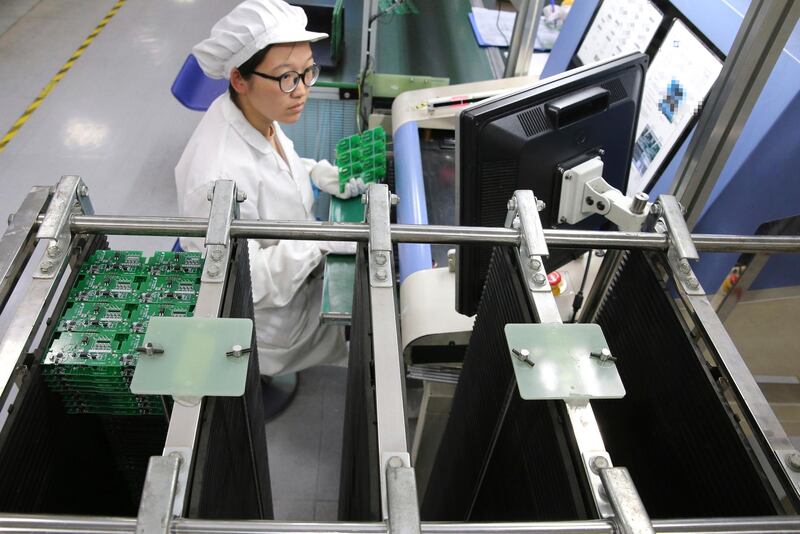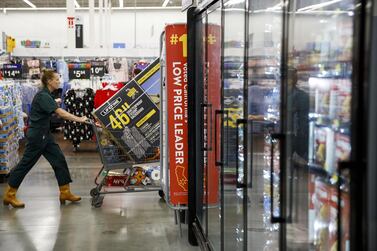The outlook for China’s manufacturing sector deteriorated further in August, underlining the weakness in the domestic economy just as a new round of tariffs kicks in.
The manufacturing purchasing managers’ index dropped to 49.5, according to data released Saturday by the National Bureau of Statistics, with sub-gauges showing that domestic and new overseas orders contracted. On Sunday, higher US tariffs on about $110 billion in Chinese imports took effect, as did Beijing’s retaliatory duties on US goods coming the other way.
US President Donald Trump’s tariff war continues to heap pressure on China’s economy and policymakers at a time when economic output already is in a long term deceleration. Until now, officials have stuck doggedly to a relatively limited package of stimulus measures out of concern that more ambitious support would further swell indebtedness and overinflate the frothy property market.
“While we find Beijing’s self-restraint admirable, we are unsure whether this well-intended master plan could be put into practice, as the risks to growth may have been underestimated,” analysts at Nomura International said in a note. Towards the end of the year the government “may be compelled to increase credit growth and ease its tightening measures on property markets again.”
The government is not sounding the alarm just yet. On Sunday, the State Council, China’s cabinet, released a statement saying that overall risks are “controllable” and the economy is stable. At the same time, countercyclical adjustments in economic policy will be increased, according to the statement.
A different, private gauge focused more on smaller companies showed manufacturing returning to expansion. The Caixin PMI rose to 50.4 in August from 49.9 in July, in data released on Monday. In Saturday’s official data there was a pickup in the PMI for small firms, although it was still in contraction.
The official data’s subindex gauging new export orders rose to 47.2, but was still in contraction, while new orders contracted further. The extra tariffs now will hit manufacturers harder.
The Trump administration imposed additional 15 per cent duties on consumer goods ranging from footwear and apparel to home textiles and certain technology products like the Apple Watch. A separate batch of about $160 billion in Chinese goods — including laptops and mobile phones — will be hit with 15 per cent tariffs on December 15.
That’s pushing many American companies to move manufacturing out of China to avoid being affected. Abercrombie & Fitch is pushing to reduce its dependence on suppliers in China by more than 40 per cent from last year’s level, but some companies are struggling to do that. Gunmaker American Outdoor Brands has tried to shift some manufacturing to other countries, but found their supply chains aren’t as sophisticated as China’s and the same components aren’t available.
In response to the US actions, China targeted US agricultural and manufacturing centres in the Midwest and South, with higher tariffs on soybeans and other farm goods, plus increased charges on US cars — where duties can now total as much as 50 per cent.
In the official PMI report, the index showing prices at the factory door continued to decline, although the renewed contraction of input prices should relieve some of the pressure on company profits.
The economy slowed in July and a set of early data collated by Bloomberg showed the trend continuing in August, with poor sales managers’ sentiment and falling trade. However, an improvement in small business confidence is a sign that earlier pro-growth measures may be having an effect.
Economists continue to warn that the trade war risks dragging the global economy into recession, a development that would ultimately feed through into Chinese domestic demand. For now, officials may take some encouragement from the relative strength of the services and construction PMI index, which rose marginally in August and remains in expansion.
That partly reflects the long-term shift of the economy away from investment and exports and towards a consumption-led growth model.
There are signs that the rapid escalation in the trade war in recent weeks could be topping out. Last week China indicated that it wouldn’t immediately retaliate against the next round of higher US duties. Trump indicated on Friday that negotiations between the two nations slated for September are still going ahead.
With each new downbeat data release, however, Chinese policymakers face greater pressure to abandon their restrained stimulus approach.
“In a macro environment with a weaker credit cycle and falling nominal growth, there is room and urgency for monetary policy to loosen, in order to prevent real interest rates from rising further,” economists at China International Capital said.







